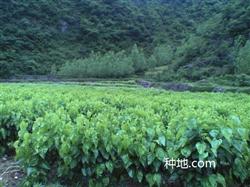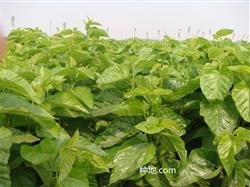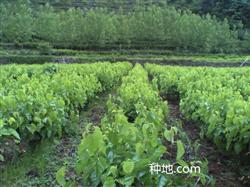What about the low yield of mulberry garden?

Mulberry garden has been planted for many years, and the output has not been high. How should we transform it? The low yield of mulberry garden can be reformed by the following methods: first, infill replanting 1, pressing plant 2, strong seedling filling: mulberry garden with wide row spacing can replant strong mulberry seedlings between plants or rows. Second, interplanting regeneration can adopt the method of interplanting renewal in the mulberry garden with older trees and declining tree potential, that is, strong mulberry seedlings can be interplanted at the density of 1000 to 1200 trees per mu, and leaves will be used as usual in the old mulberry and spring silkworm period. The newly planted mulberry is cut in spring, and the tube is strengthened to promote exuberant growth. Rejuvenation and grafting 1. Rejuvenation: for mulberry trees with high tree type, thin and short branches and declining growth potential, the method of cutting off the trunk can be adopted before the sap flow in spring, and the branches can be reduced by 1 or 2 layers. Because there are many latent buds in the branches, cut off the branches as much as possible when falling into the trunk, and pay attention to thinning the buds and leaving the branches after germination to re-cultivate the branches. 2. Grafting and replacement: it is suitable for the transformation of fruiting mulberry and bad mulberry varieties, especially real mulberry, with many flowers and fruits, small leaf shape and low leaf yield, but with developed root system and prosperous growth, grafting good mulberry varieties can quickly form a forest and increase mulberry leaf yield. Low dry mulberry adopts root digging grafting, medium and high dry mulberry adopts multiple grafting, and young mulberry adopts tubular bud grafting or skin bud grafting. After grafting, the management should be strengthened and the tree type should be formed. Due to the well-developed root system of the mother tree, the new mulberry grows strongly after the new bud grows to a certain height, so it can pick out the core according to the requirements of shearing, promote the branch, and develop 2-3 branches in the same year, so as to shorten the years of developing tree type and significantly increase the yield of mulberry leaves. Fourth, spring cutting and cutting mulberry trees that have declined due to poor management can be rejuvenated by spring cutting, that is, before mulberry sprouting in spring, all the existing branches are cut off from the base 2 to 3 centimeters according to the original nurturance form. all the poorly growing branches, withered piles and dead fists are cut off, and the buds are thinned reasonably, weak and strong, and each branch retains 2-3 buds. The mulberry with good trunk, declining tree potential, short branches and small number of clockwork can be cut off at the top of the bifurcation, strengthen fertilizer and water management, and promote its re-germination to form a branch group, which can achieve the purpose of rejuvenation. Fifth, strengthen the management of fertilizer cultivation: one of the important factors of low yield in mulberry garden is the serious lack of fertilizer, so fertilizer is the material basis for high yield in mulberry garden. Generally, the leaf yield is converted to pure nitrogen, and the yield of mulberry leaves can be increased by 50 kg per kilogram of pure nitrogen. Therefore, it is necessary to increase the amount of fertilizer applied in low-yield mulberry garden, and pay attention to the combined application of N, P and K fertilizer, the ratio of N, P and K fertilizer is 7:3:4, especially in sandy beach and yellow mud soil. Fertilization in each season accounts for 30% of the annual fertilizer application: spring fertilizer accounts for 30%, summer and autumn fertilizer accounts for 50-60%, and winter fertilizer accounts for 10-20%, in order to meet the fertilizer needs of mulberry growth. See more mulberry planting techniques
- Prev

How to fertilize mulberry trees to achieve high yield?
What kind of fertilization method can make mulberry high yield? Mulberry is a crop that needs a lot of fertilizer, and it is necessary to put in enough fertilizer to obtain high yield. the annual fertilizer amount of one mu of mature mulberry is 240jin of urea, 200jin of common calcium, 40jin of potash fertilizer and 2000 jin of organic fertilizer. Fertilize 4 times in the whole year, spring fertilizer is in the middle of March.
- Next

How to manage the mulberry garden in spring?
How to manage the mulberry garden in spring? The main points of spring mulberry garden management are as follows: strengthen fertilizer and water management. Spring fertilizer can be applied about 20 days before mulberry germination. The mulberry trees used for feeding young silkworms were applied first, and the strong silkworms were applied after mulberry; mulberry fields on clay land were applied first, and sandy land was applied later. It usually starts at the beginning of March.
Related
- Fuxing push coffee new agricultural production and marketing class: lack of small-scale processing plants
- Jujube rice field leisure farm deep ploughing Yilan for five years to create a space for organic food and play
- Nongyu Farm-A trial of organic papaya for brave women with advanced technology
- Four points for attention in the prevention and control of diseases and insect pests of edible fungi
- How to add nutrient solution to Edible Fungi
- Is there any good way to control edible fungus mites?
- Open Inoculation Technology of Edible Fungi
- Is there any clever way to use fertilizer for edible fungus in winter?
- What agents are used to kill the pathogens of edible fungi in the mushroom shed?
- Rapid drying of Edible Fungi

